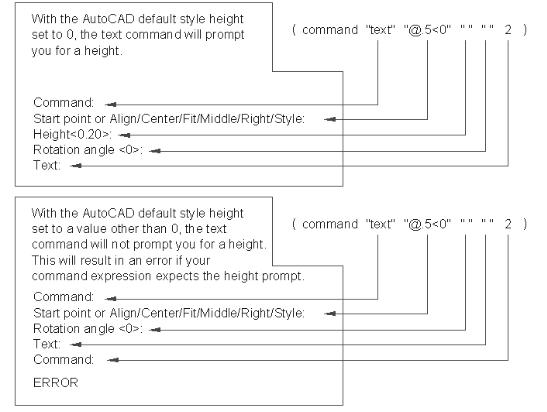
- •Introduction
- •Who should read this book
- •How This Book Is Organized
- •How to Use This Book
- •Where to Find the LISP Programs
- •CHAPTER 1: Introducing AutoLISP
- •Understanding the Interpreter and Evaluation
- •The Components of an Expression
- •Using Arguments and Expressions
- •Using Variables
- •Understanding Data Types
- •Integers and Real Numbers
- •Strings
- •Lists
- •File Descriptors
- •Object Names
- •Selection Sets
- •Symbols
- •Subrs
- •Atoms
- •Assigning Values to Variables with Setq
- •Preventing Evaluation of Arguments
- •Applying Variables
- •Functions for Assigning Values to Variables
- •Adding Prompts
- •CHAPTER 2: Storing and Running Programs
- •Creating an AutoLISP Program
- •What you Need
- •Creating an AutoLISP File
- •Loading an AutoLISP file
- •Running a Loaded Program
- •Understanding How a Program Works
- •Using AutoCAD Commands in AutoLISP
- •How to Create a Program
- •Local and Global Variables
- •Automatic Loading of Programs
- •Managing Large Acad.lsp files
- •Using AutoLISP in a Menu
- •Using Script Files
- •CHAPTER 3: Organizing a Program
- •Looking at a Programs Design
- •Outlining Your Programming Project
- •Using Functions
- •Adding a Function
- •Reusing Functions
- •Creating an 3D Box program
- •Creating a 3D Wedge Program
- •Making Your Code More Readable
- •Using Prettyprint
- •Using Comments
- •Using Capitals and Lower Case Letters
- •Dynamic Scoping
- •CHAPTER 4: Interacting with the Drawing Editor
- •A Sample Program Using Getdist
- •How to Get Angle Values
- •Using Getangle and Getorient
- •How to Get Text Input
- •Using Getstring
- •Using Getkword
- •How to Get Numeric Values
- •Using Getreal and Getint
- •How to Control User Input
- •Using Initget
- •Prompting for Dissimilar Variable Types
- •Using Multiple Keywords
- •How to Select Groups of Objects
- •Using Ssget
- •A Sample Program Using Ssget
- •CHAPTER 5: Making Decisions with AutoLISP
- •Making Decisions
- •How to Test for Conditions
- •Using the If function
- •How to Make Several Expressions Act like One
- •How to Test Multiple Conditions
- •Using the Cond function
- •How to Repeat parts of a Program
- •Using the While Function
- •Using the Repeat Function
- •Using Test Expressions
- •CHAPTER 6: Working With Geometry
- •How to find Angles and Distances
- •Understanding the Angle, Distance, and Polar Functions
- •Using Trigonometry to Solve a Problem
- •Gathering Information
- •Finding Points Using Trigonometry
- •Functions Useful in Geometric Transformations
- •Trans
- •Atan
- •Inters
- •CHAPTER 7: Working with Text
- •Working With String Data Types
- •Searching for Strings
- •Converting a Number to a String
- •How to read ASCII text files
- •Using a File Import Program
- •Writing ASCII Files to Disk
- •Using a Text Export Program
- •CHAPTER 8: Interacting with AutoLISP
- •Reading and Writing to the Screen
- •Reading the Cursor Dynamically
- •Writing Text to the Status and Menu Areas
- •Calling Menus from AutoLISP
- •Drawing Temporary Images on the Drawing Area
- •Using Defaults in a Program
- •Adding Default Responses to your Program
- •Dealing with Aborted Functions
- •Using the *error* Function
- •Organizing Code to Reduce Errors
- •Debugging Programs
- •Common Programming Errors
- •Using Variables as Debugging Tools
- •CHAPTER 9: Using Lists to store data
- •Getting Data from a List
- •Using Simple Lists for Data Storage
- •Evaluating Data from an Entire List at Once
- •Using Complex Lists to Store Data
- •Using Lists for Comparisons
- •Locating Elements in a List
- •Searching Through Lists
- •Finding the Properties of AutoCAD Objects
- •Using Selection Sets and Object Names
- •Understanding the structure of Property Lists
- •Changing the properties of AutoCAD objects
- •Getting an Object Name and Coordinate Together
- •CHAPTER 10: Editing AutoCAD objects
- •Editing Multiple objects
- •Improving Processing Speed
- •Using Cmdecho to Speed up Your Program
- •Improving Speed Through Direct Database Access
- •Filtering Objects for Specific Properties
- •Filtering a Selection Set
- •Selecting Objects Based on Properties
- •Accessing AutoCAD's System Tables
- •CHAPTER 11: Accessing Complex Objects
- •Accessing Polyline Vertices
- •Defining a New Polyline
- •Drawing the new Polyline
- •Testing for Polyline Types
- •How Arcs are Described in Polylines
- •Accessing Object Handles and Block Attributes
- •Using Object Handles
- •Using Object Handles
- •Extracting Attribute Data
- •Appendix A: Menu Primer
- •Appendix B: Error Messages
- •Appendix C: Group Codes

The ABC’s of AutoLISP by George Omura
How to read ASCII text files
There are many reasons why you may want to have a program read from and write to an ASCII file. You may store commonly used general notes in ASCII files on your hard disk which you would import into your drawing. Or you may want to store drawing information on disk for later retrieval such as layering setup or block lists.
Using a File Import Program
The program shown in figure 7.11 is a rudimentary text import program. In this section, you will use it to examine the way AutoLISP reads external ASCII files.
(Defun C:IMPRT (/ sp dt stl qst)
(setq nme (getstring "\nName of text file to import: ")) (setq sp (getpoint "\nText starting point: "))
(setq txt (open nme "r")) (setq dt (read-line txt))
(setq lns (getdist "\nEnter line spacing in drawing units: ")) (setq ls (rtos lns 2 2))
(setq ls (strcat "@" ls "<-90")) (command "text" sp "" "" dt)
(while (/= dt nil)
(setq dt (read-line txt)) (command "text" ls "" "" dt)
)
(close txt) (command "redraw")
)
Figure 7.11: A text import program
Create an ASCII file containing the program in figure 7.13. Give it the name Imprt.lsp. Go back to the Chapt7 AutoCAD file and load the Imprt.lsp file. Now run the program:
1.Enter imprt at the Command prompt.
2.At the prompt:
Name of text file to import:
Enter imprt.lsp.
152
Copyright © 2001 George Omura,,World rights reserved
The ABC’s of AutoLISP by George Omura
3. At the next prompt:
Text starting point:
pick a point at coordinate 2,8. 4. At the next prompt:
Enter line spacing in drawing units:
enter .4.
The contents of the file Imprt.lsp will be written into the drawing area using AutoCAD text.
The C:IMPRT program starts out by prompting the user to identify the file to be imported. The user is prompted to enter the name of the file to be imported:
(Defun C:IMPRT (/ sp dt stl qst)
(setq nme (getstring "\nName of text file to import: "))
The entered name is saved as the variable nme. Next, the starting point is gotten:
(setq sp (getpoint "\nText starting point: "))
This point is saved as sp. The last prompt sets up the line spacing:
(setq lns (getdist sp "\nEnter line spacing in drawing units: "))
The spacing distance is assigned to the variable lns. Note that getdist is used so the user can input a distance either through the keyboard or cursor.
In the next line, the AutoLISP function open is used to open the file to be imported:
(setq txt (open nme "r"))
In this expression, you are telling AutoLISP to open a file to be read, then assign that file to the variable txt. From this point on, you can treat the variable txt as if it were a read only version of the file itself. This variable that assumes the idobject of the file is called the file descriptor. At first, it may seem confusing that you assign the file name to a variable that is used to locate and open the file then assign the open file to a variable of a different name. But you cannot perform file reads and writes directly through a variable of the same name as the file. You can, however, assign an open file to a symbol then treat that symbol as if it were the file itself.
The syntax for open is:
(open [name of file] [read or write code])
The first argument is the name of the file to be opened. The second argument is a code that tells AutoLISP whether to allow read only, write only or appending operations on the file. The following table shows the codes and their meaning.
153
Copyright © 2001 George Omura,,World rights reserved
The ABC’s of AutoLISP by George Omura
Code Uses
"r"
"w"
"a"
Open a file for reading only. If the file does not exist, any attempts to read from it will result in an error message.
Open a file to write to. If the file already exists, its contents will be written over. If the file does not exist, it will be created
Open a file and append to the end if it. If the file does not exist, it will be created.
The next line uses the AutoLISP function read-line to read the first line of text from the open file:
(setq dt (read-line txt))
A line of text is read from the file represented by the symbol txt and is assigned to the variable dt. Read-line has only one argument, the file descriptor. When the file is first opened, AutoLISP goes to the beginning of the file in preparation to read it. Read-line reads the first line then AutoLISP moves to the second line waiting for further instructions to read the file. The next time the expression:
(read-line txt)
is evaluated, AutoLISP will read the next line after the previously red line then move to the following line and wait for another read-line function call.
The next two lines set up the location of the beginning of the text in the drawing editor:
(setq ls (rtos lns 2 2))
(setq ls (strcat "@" ls "<-90"))
The numeric value entered at the line spacing prompt is converted to a string then appended to the "@" and "<-90" strings to create a string that can be used in the text command that follows. The next line writes the text from the first line of the file into the AutoCAD drawing:
(command "text" sp "" "" dt)
The following while expression continually reads lines from the open file and writes them to the AutoCAD drawing editor:
(while (/= dt nil)
(setq dt (read-line txt))
(command "text" ls "" "" dt)
)
The read-line function will return nil when it reaches the end of the file. At that point, the while expression stops its recursion).
154
Copyright © 2001 George Omura,,World rights reserved

The ABC’s of AutoLISP by George Omura
Finally, to take care of housekeeping, the open file is closed.
(close txt)
This is a very important step in the file reading process. If a file is not closed, the contents of that file can be lost.
We should mention that C:IMPRT requires the current text style to have a height value of 0. If this is not the case, then the program will not work properly. This is because in the line that actually writes the text into the drawing editor:
(command "text" ls "" "" dt)
assumes that AutoCAD will prompt for a height value for the text. The height prompt occurs only when the current text style has a height value of 0. If the current text style has a height value other than 0, the height prompt is skipped. This would cause the above expression to add one too many returns in the text command sequence (see figure 7.12).
Figure 7.12: The text command expects specific input
155
Copyright © 2001 George Omura,,World rights reserved
